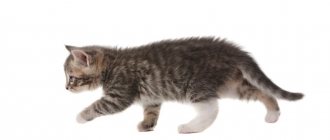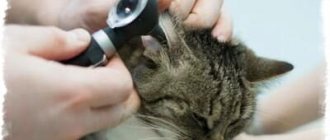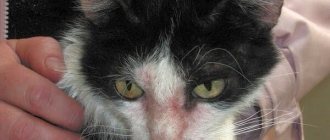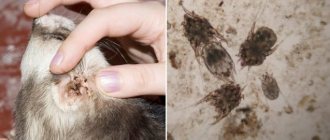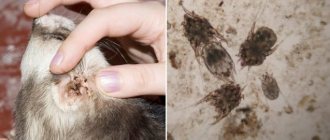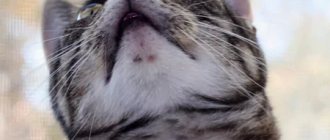Why is rhinitis dangerous for cats?
A runny nose in cats is a common disease, but it is not at all as harmless as some owners believe. A cat's nose is an unusually sensitive instrument, a kind of odor indicator. For this reason, animals can easily figure out where the desired object is, even when it is located at a great distance. Cats' nasal passages are narrow, and swelling caused by inflammation can completely block the nose. A runny nose in a cat is an unpredictable disease. Blocked nasal passages do not cope with their functions of cleaning and warming the air. The animal can only breathe through the mouth; cold air easily penetrates into the lungs. This can provoke hypothermia and an inflammatory process. A cat experiencing oxygen starvation becomes lethargic and lifeless, which leads to exhaustion and dehydration. If you do not treat rhinitis in a cat, it will become chronic, and the life of your pet will turn into sheer agony.
Why does a cat sneeze?
Sneezing in cats can be caused by unfavorable factors of various natures. For example, the sneeze reflex in animals is a reaction to the influence of any allergen that irritates the mucous membrane of the upper respiratory tract. The ingress of dust particles, pollen from flowering plants, and household chemicals irritate the receptors in the nasal mucosa, which is accompanied by sneezing.
The cat sneezes
Important! As a rule, sneezing in cats and other animals is caused by irritation of the nerve endings located on the mucous membrane of the respiratory tract.
Often, sneezing can be a symptom of a respiratory illness. A common runny nose, as a rule, is always accompanied by a reflexive sneezing reflex. Thus, the animal’s body clears the respiratory tract from accumulated exudate.
recommended articles:
- Pneumonia in cats
- Antiviral drugs for cats
Cats, cats, kittens sneeze when:
- asthma;
- colds;
- viral, bacterial, fungal infections;
- the presence of polyps in the nose;
- neoplasms in the respiratory tract, upper respiratory tract;
- severe hypothermia;
- congenital pathologies, anatomical defects in the structure of the respiratory organs;
- chronic respiratory diseases (tonsillitis, rhinotracheitis, sinusitis);
- the presence of foreign objects in the larynx.
The sneezing reflex in cats can be triggered by sharp, pungent odors, for example, perfume, eau de toilette, air freshener, tobacco smoke. Molds that live on wall surfaces, congenital pathologies, and anatomical defects of the respiratory tract organs provoke sneezing attacks in cats.
Once in the upper respiratory tract, allergens of various nature irritate the mucous membranes and lead to frequent sneezing. Sneezing and sniffling in cats are often signs of seasonal allergies.
Symptoms of rhinitis in cats
There are signs that will tell you that your furry pet is suffering from rhinitis. These include:
- Difficulty breathing. After active actions, running or playing, the animal's breathing becomes heavy. Swollen nasal passages do not allow sufficient oxygen to be received; the cat gasps for air.
- A state of detachment, indifference to everything around. The animal falls into apathy; games, entertainment and treats do not interest him.
- The cat is trying to put its nose in order on its own, scratching the diseased organ with its paw, moving it over furniture and other objects.
- The temperature may rise (up to 39 C), the cat’s nose becomes hot.
- Often a runny nose is accompanied by conjunctivitis, the cat's eyes swell, and pus collects in the corners.
- Nasal discharge.
The types of rhinitis vary, as does nasal discharge. The acute form of a runny nose is characterized by copious clear discharge. When a cat sneezes frequently and endlessly rubs its nose on furniture and other objects, there is reason to think about allergic rhinitis. If the cause of a runny nose is a viral infection, the discharge from the animal's nose will be the color of pus.
When rhinitis is caused by damage to the inner lining of the nose, the discharge is bloody and flows from only one nostril. With any type of rhinitis, crusts of dried discharge are visible under the animal’s nose.
What do we have to do?
The best thing you can do for your pet is to take him to a veterinarian, who will find out why the disease appeared. However, some owners try to treat their cat at home. Such help is reminiscent of playing roulette, because the owner does not know exactly what caused the illness.
The owner should be especially concerned if sneezing is combined with the following symptoms:
- bleeding from the nose;
- depressed state of the cat;
- elevated temperature;
- reduction in animal body weight;
- ulcers and rashes on the cat’s skin;
- profuse lacrimation;
- discharge of pus from the nasal passages and eyes;
- wheezing and whistling when breathing;
- cough;
- behavior change;
- vomit;
- diarrhea.
This combination indicates that your pet is not just allergic to dust, but has a serious illness. Moreover, some of the cat diseases can be transmitted to people.
So, if a cat sneezes and her eyes are watery, what should you do about it? Don’t wait for this to go away on its own, but go to a veterinary clinic where your pet will undergo a full examination.
What causes a runny nose in cats?
There are several reasons. They are caused by improper nutrition and care of the animal, arise as a result of infection, or are a concomitant disease with oncology or other serious pathologies.
- Purebred pets often suffer from allergic rhinitis. This is how their body reacts to plant pollen, chemicals, medications, cleaning products, and cosmetics.
- A runny nose can be one of the signs of a serious infectious disease - pneumonia, tuberculosis.
- Rhinitis sometimes appears in an animal after prolonged hypothermia, ingestion of cold food or water.
- Hot air and steam can cause a runny nose. When a cat is near boiling water for a long time, or its fur is dried with a hairdryer, its body may react with acute rhinitis.
- The presence of foreign objects (fluffs, grains of sand) in the nasal passages also causes a runny nose.
- Oncological diseases that are localized in the nasal passages.
How to help a cat
If your cat's sneezing is not accompanied by accompanying symptoms, you can help the animal at home.
For example, dust getting into the respiratory tract is the safest reason. It is caused by the body's protective reaction. First of all, it is necessary to carry out wet cleaning or remove the pet from the dusty room. If an allergy occurs, it is recommended to remove the source of the allergen into the air from the room. It is best to purchase other household chemicals and change the type of toilet filler. If your pet sneezes from a houseplant, you should remove the houseplant as far as possible. Simply removing the stamens and pollen from flowers helps. As a rule, this is enough to eliminate unpleasant symptoms in the animal. To prevent infectious and colds, you need to add vitamins to your food and balance your pet’s diet. You should not postpone a visit to the veterinarian if your animal’s condition worsens.
How to treat a runny nose in a cat
Owners should take the disease seriously. First, you need to show your pet to a veterinarian. The doctor will determine what happened to your pet and prescribe the necessary medicine. Treatment of a runny nose begins with eliminating the underlying cause. If a cat has an infectious disease, an antibiotic, Baytril or Amoxiclav, will help him. When a viral infection occurs, the doctor will prescribe Giscan, Vitafel, Neotime. If we are talking about a fungal disease, you will need the drug "Biopirox". The crusts are removed with a cotton swab soaked in hydrogen peroxide. In case of severe nasal congestion, special drops are used for 7 days to constrict blood vessels. The nose is washed with a solution of boiled salt, after wrapping the pet in a towel. You can warm up the animal's nose with a bag of hot sand. It is quite possible to cure a runny nose in a cat on your own. But at the same time, do not neglect the services of a veterinarian, so as not to miss the onset of a serious illness, to prevent the transition of the acute stage of rhinitis to the chronic stage.
Treatment of sneezing
After the owner or veterinarian has found out why the pet is sneezing and made a diagnosis, the appropriate treatment for the pet is selected. A common runny nose should be treated with nasal drops, antibiotics and other standard anti-inflammatory drugs that destroy pathogenic bacteria and viruses. All medications are added to the animal’s food until the runny nose and sneezing go away.
At home, runny nose and infectious diseases can be treated with infusions and decoctions of medicinal herbs. If the snot is thick, then your nose should be rinsed with beetroot juice. In case of chronic runny nose, the nasal mucosa needs to be dried. This is done using streptocide powder or vasoconstrictor drops.
If you have problems with your teeth, you need to go to the dentist. He will prescribe treatment for damaged teeth and gums, eliminate the causes of inflammation and the sneezing will stop. Sneezing caused by an allergy to mold is treated with special ointments that the owner must apply to the cat’s nose. Allergies are also treated with special antiallergic drugs and by eliminating the allergen from the pet’s environment. Sneezing caused by an eye infection that causes watery eyes is treated with special drops containing natural plant extracts.
Sorry, there are no surveys available at this time.
If your kitten is sneezing due to an asthma attack, hold it over the steam for a few minutes. It helps expand the lungs and the attack will pass. Parasites are eliminated with the help of anthelmintic drugs, which can only be prescribed by a doctor.
When a cat sneezes due to a foreign object in the nose, the owner can quickly help her. He can easily pull it out with the help of special tools, but this must be done very carefully, otherwise you can deprive the cat of his sense of smell.
If a cat does this because of a tumor in the nasal cavity, it cannot be cured on its own. He needs urgent hospitalization and close medical supervision.
When an animal is sick, the owner must create all the conditions to alleviate its condition. To do this, you must follow all the veterinarian's instructions. If your eyes are watery, they need to be wiped to remove the discharge. After contact with a sick animal, you need to wash your hands thoroughly, as some diseases of cats can be transmitted to people, for example, toxoplasmosis. If your cat has a high fever, runny nose, or continuous cough, you should urgently call a veterinarian.
What can you do at home?
Here's how you can help your cat:
Ensure a comfortable temperature in the room where the cat lives, because overheating, like hypothermia, has a negative effect on its body
It is also important to avoid low humidity, since in this case the pet’s mucous membranes dry out and cease to protect the animal from bacteria and dust. As a result, pathogens penetrate the body faster. Avoid dehydration, which often occurs when the temperature rises and the cat completely refuses water.
The owner will have to force-feed the pet from a syringe. If it is not possible to get him to drink in this way, it is allowed to administer saline or Ringer's solution intravenously. Force feed your pet if it refuses food for 3 days or more. You can offer your cat food that is not too heavy: high-quality wet food, finely chopped boiled chicken liver, low-fat broth, cottage cheese. In addition, you can try to stimulate your cat's appetite with food with a distinct smell. Introduce vitamins into your pet's diet. It is better to give preference to drugs in the form of injections, since the absorption of nutrients at this time is reduced. Use only those medications prescribed by your doctor to treat your cat.
Video "Sneezing cats"
We present to your attention a video collection of funny sneezing cats.
Was this article helpful?
Thank you for your opinion!
The article was useful. Please share the information with your friends.
Yes (100.00%)
No
X
Please write what is wrong and leave recommendations on the article
Cancel reply
Rate the benefit of the article: Rate the author ( 7 votes, average: 4.29 out of 5)
Discuss the article:



